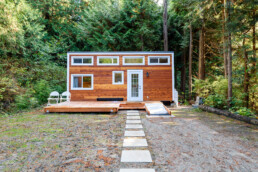What is an ADU in California? A Homeowner’s Guide to Building One
If you’ve been hearing the term ADU pop up more and more, you’re not alone. Accessory Dwelling Units (ADUs) have become a hot topic in California real estate, and for good reason. Whether you’re looking to create a rental unit, house family members, or just add more space to your property, an ADU can be a game-changer.
When I first started looking into building an ADU, I had a million questions. What exactly is an ADU? Can I build one on my property? How much will it cost? If you’re wondering the same things, you’re in the right place. Here’s a breakdown of everything you need to know about what an ADU is in California and whether it’s the right choice for you.
What is an ADU in California?
An Accessory Dwelling Unit (ADU) is a secondary housing unit on a residential property. It can be:
✔ Detached – A separate structure from the main house (like a backyard cottage).
✔ Attached – An addition to the existing home (such as a unit over a garage).
✔ Converted Space – A repurposed area inside the primary home, like a basement or garage.
ADUs are fully functional living spaces that include a kitchen, bathroom, and sleeping area. They can be rented out or used for personal reasons—many homeowners build them for aging parents, adult children, or even as a home office.
Why Are ADUs So Popular in California?
California has been facing a serious housing shortage, and ADUs offer a smart, affordable solution. The state has passed several laws to make ADU construction easier for homeowners. Here’s why so many Californians are choosing to build ADUs:
- Affordable Housing Solution – ADUs help increase rental housing options in high-cost areas.
- Rental Income – Many homeowners use ADUs to generate passive income.
- Multi-Generational Living – ADUs are perfect for keeping family close while maintaining privacy.
- Property Value Boost – Adding an ADU can increase your home’s resale value.
- No Need to Buy a New Home – If you need more space, an ADU is often cheaper than moving.
What Are the Different Types of ADUs in California?
Not all ADUs are built the same! Depending on your property and goals, you might consider one of the following:
1. Detached ADU
- A standalone unit, separate from the main house.
- Often built in the backyard.
- Can be up to 1,200 square feet in most California cities.
2. Attached ADU
- Built as an addition to the primary home.
- Shares a wall with the main house but has its own entrance.
- Maximum size is 50% of the existing home’s size, up to 1,000 square feet.
3. Garage Conversion ADU
- Converts an existing garage into a fully livable unit.
- One of the most affordable ADU options.
- May or may not include expanding the structure.
4. Basement or Attic Conversion ADU
- Transforms an underutilized basement or attic into an independent living space.
- Ideal for homes with limited backyard space.
5. Junior ADU (JADU)
- A smaller unit within the existing home (max 500 square feet).
- Must be part of the main house (like a converted bedroom).
- Can share a bathroom with the main home.
Can I Build an ADU on My Property?
Great news—California has made it easier than ever to build an ADU! However, local regulations still apply, so here are some general rules to know:
✔ Single-family and multi-family lots can build ADUs.
✔ You can have both an ADU and a Junior ADU (JADU) on the same lot.
✔ Setback requirements: ADUs need at least 4 feet of side and rear clearance.
✔ No minimum lot size requirements – Even small lots can have an ADU.
✔ No owner-occupancy requirement for ADUs (until 2025, at least).
The specific rules vary by city and county, so check with your local planning department before starting construction.
How Much Does It Cost to Build an ADU in California?
The cost of building an ADU depends on size, design, and location. Here’s a rough breakdown:
- Garage Conversion ADU: $80,000 – $150,000
- Attached ADU: $100,000 – $250,000
- Detached ADU: $150,000 – $400,000
- Luxury ADU: $300,000+ (custom design, high-end finishes)
Pro Tip: Some cities offer grants and low-interest loans to help homeowners finance ADUs. It’s worth checking if you qualify!
Do I Need a Permit to Build an ADU in California?
Yes, you absolutely need permits to build an ADU. The permitting process involves:
- Planning Department Approval – Ensuring your ADU meets local zoning laws.
- Building Permits – Structural, electrical, and plumbing permits are required.
- Final Inspection – Once construction is complete, the city will inspect and approve the unit.
The good news? Many ADUs qualify for fast-track approval under recent California laws, reducing the time and cost of getting permits.
Is an ADU Right for You?
If you own a home in California, adding an ADU could be one of the best investments you ever make. Whether you’re looking to earn rental income, create space for family, or increase your home’s value, an ADU offers flexibility and financial benefits.
Before you start, make sure to:
✔ Check your local ADU regulations.
✔ Get multiple contractor quotes.
✔ Consider your budget and financing options.
Final Thoughts
Now that you know what an ADU is in California, you’re one step closer to making it a reality! I was hesitant at first, but after going through the process myself, I can confidently say that building an ADU was one of the best decisions I’ve made as a homeowner.
If you’re thinking about adding an ADU, do your research, talk to professionals, and take advantage of the new laws that make the process easier and more affordable than ever.

